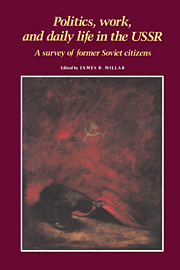Book contents
- Frontmatter
- Contents
- Foreword
- List of contributors
- PART I INTRODUCTION
- PART II POLITICS: SOURCES OF REGIME SUPPORT
- PART III WORK: ECONOMIC/DEMOGRAPHIC TRENDS
- 6 Inequality of earnings, household income, and wealth in the Soviet Union in the 1970s
- 7 The life course of Soviet women born 1905–1960
- 8 Productivity, slack, and time theft in the Soviet economy
- PART IV LIFE: SOCIAL STATUS, ETHNIC RELATIONS, AND MOBILIZED PARTICIPATION
- Appendix A The SIP General Survey sample
- Appendix B Response effects in SIP's General Survey of Soviet emigrants
- Glossary
- General bibliography of Soviet Interview Project publications
- Index
6 - Inequality of earnings, household income, and wealth in the Soviet Union in the 1970s
Published online by Cambridge University Press: 21 March 2010
- Frontmatter
- Contents
- Foreword
- List of contributors
- PART I INTRODUCTION
- PART II POLITICS: SOURCES OF REGIME SUPPORT
- PART III WORK: ECONOMIC/DEMOGRAPHIC TRENDS
- 6 Inequality of earnings, household income, and wealth in the Soviet Union in the 1970s
- 7 The life course of Soviet women born 1905–1960
- 8 Productivity, slack, and time theft in the Soviet economy
- PART IV LIFE: SOCIAL STATUS, ETHNIC RELATIONS, AND MOBILIZED PARTICIPATION
- Appendix A The SIP General Survey sample
- Appendix B Response effects in SIP's General Survey of Soviet emigrants
- Glossary
- General bibliography of Soviet Interview Project publications
- Index
Summary
Introduction
At least in the popular mind, socialism is associated with economic equality. The issue of whether or not incomes on the Soviet Union and the other members of the “socialist” bloc are distributed in a more equal fashion than in the mixed economies of the West has, therefore, been addressed by students in both the East and the West.
The scarcity of relevant data published in the Soviet Union adds to the many natural and methodological problems that any attempt at international comparison of equality must face. Raw data are completely unavailable to Western scholars, and whatever is published in Soviet scientific work is usually restricted to a very few measures of dispersion, mostly the decile ratio, and both the methodology and information about the nature of the samples that have been studied are at best obscure. As it is quite clear that Soviet authorities possess that necessary information, withholding it from the public eye must be attributed to the embarrassment that publication would cause. The source of such embarrassment is not entirely clear. Peter Wiles suggests that the main problem is that income in the Soviet Union is distributed less equally than in other East European countries (1974: 1–2), but one cannot exclude internal considerations or embarrassment on the basis of international, East–West comparisons.
Given the problem of data and the ideological sensitivity of the issue, it is no wonder that views on Soviet income inequality are open to dispute.
- Type
- Chapter
- Information
- Politics, Work, and Daily Life in the USSRA Survey of Former Soviet Citizens, pp. 171 - 202Publisher: Cambridge University PressPrint publication year: 1987
- 2
- Cited by



